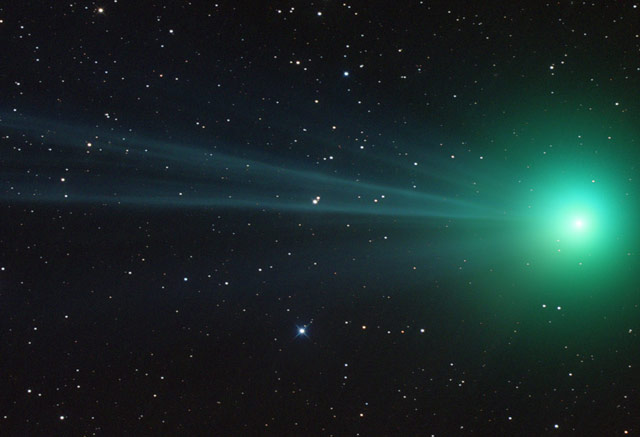Nebulae

Andromeda the Chained Princess 
Andromeda stands in the northern sky eternally chained to her rock. She is one of the five constellations that Ptolemy described in the second century, all part of one particular ancient Greek myth. In the constellation is a quadruple star, a blue snowball, exoplanets and spiral galaxies.
Astronomy Photographer of the Year 2014 
There´s a serene aurora, both a violent Sun and an eclipsed one, a stellar nursery and a stellar graveyard, and many more superb pictures. The Astronomy Photographer of the Year 2014 winners were announced in September and you can see all of them.
Canis Major - the Greater Dog 
In a sky full of gods, heroes and wronged women, there are also four dogs. We have Canis Minor and the two dogs of Canes Venatici, but Canis Major is definitely top dog. It´s a prominent constellation that has represented a dog from early Greek times.
Cats in the Sky 
There are three constellations named for dogs, but what about cats in the sky? There is astrocat Felicette who went into space and returned safely to Earth, but also constellations of big cats and a pawprint 50 light years across.
Charles Messier – Comet Ferret 
The Crab Nebula is M1 and the Andromeda Galaxy is M31. Over a hundred deep-sky objects with "M" numbers are listed in the Messier Catalogue. Charles Messier, 18th-century comet hunter, is known today less for his comets and more for his catalog of things that aren´t comets.
Charles Messier – Comet Ferret 
The Crab Nebula is M1 and the Andromeda Galaxy is M31. Over a hundred deep-sky objects with "M" numbers are listed in the Messier Catalogue. Charles Messier, 18th-century comet hunter, is known today less for his comets and more for his catalog of things that aren't comets.
Chemical Cosmos - book review 
"The Chemical Cosmos: A Guided Tour" is an astronomy book about chemistry - or perhaps a chemistry book about astronomy. It´s an engrossing guided tour that will take you from the baby Universe through the first stars, the formation of solar systems and to our search for the origins of life.
Cosmic 4th of July 
What links the USA's Independence Day holiday, the Crab Nebula and NASA's Deep Impact spacecraft? What links the American War of Independence with the planet Uranus? And what is the Fireworks Galaxy? Here's the story.
Cosmic 4th of July 
What links the USA´s Independence Day holiday, the Crab Nebula and NASA´s Deep Impact spacecraft? What links the American War of Independence with the planet Uranus? And what is the Fireworks Galaxy? Read on to find out.
Cosmic Father´s Day 
What sort of tie would you give a cosmic father? What would you feed him? Where might he find challenging mountaineering, make an astounding golf shot or get up an interstellar soccer game? How can you send a special man a genuinely galactic greeting? Here´s how.
Cosmic Ghosts, Ghouls and Vampires 
Astronomers use colorful language for cosmic objects. But unlike ghosts, ghouls and vampires in horror stories, the cosmic ones aren´t scary late at night. Here are tales of the birth, evolution and death of stars, a blinking demon and a star that, at Halloween, seems like the Sun´s ghost.
Cosmic White Christmas 
If you´re dreaming of a white Christmas, the cosmos may have something of interest. How about deep snow on one of Saturn´s moons, a gigantic Christmas tree whose lights are baby stars, a snowman on an asteroid or an Einstein ring?
Creepy Crawlies in Space 
What was the first Earth creature to go into space? Not a dog, but a fruit fly. Insects and arachnids have been mini-astronauts for over sixty years. They have also inspired the naming of heavenly objects.
Creepy Crawlies in Space 
What was the first Earth creature to go into space? Not a dog, but a fruit fly. Insects and arachnids have been mini-astronauts for over sixty years. They have also inspired the naming of heavenly objects.
Exotic Creatures of the Southern Sky 
Constellations telling the ancient tales of gods and heroes are still in use by astronomers. But there are only 48 classical constellations, and the skies around the south celestial pole can't be seen from the Mediterranean, so those constellations are more modern. Here are some of them.
Exotic Creatures of the Southern Sky 
Constellations telling the ancient tales of gods and heroes are still in use by astronomers. But there are only 48 classical constellations, and the skies around the south celestial pole can´t be seen from the Mediterranean, so those constellations are more modern. Here are some of them.
Galactic Winter Games 
Welcome to the Galactic Winter Games, a starry tribute to Earth´s Winter Olympic Games. It´s a tour of some really cool cosmic sights – as well as some hot ones, such as one of the biggest explosions in the Universe.
Gemini - the Celestial Twins 
Gemini. A story of the love and loyalty of two brothers parted only by death. Includes a star that´s actually a system of six stars, and a giant star that can help us measure distances in space. Contains an object that completely baffled astronomers for twenty years.
Gemini – the Celestial Twins 
Gemini. A story of the love and loyalty of two brothers parted only by death. Includes a star that's actually a system of six stars, and a giant star that can help us measure distances in space. Contains an object that completely baffled astronomers for twenty years.
Lagoon Nebula (M8) 
Barely visible to the unaided eye, Messier 8 (M8) – the Lagoon Nebula – lies about five thousand light years away in the constellation Sagittarius. It's over a hundred light years across, an enormous turbulent stellar nursery.
Life and Death of the Sun 
In the distant future the Sun will be many times its present size and thousands of times brighter. It will seed the Galaxy with elements like carbon and oxygen–perhaps for life on a world yet unborn. Then it will collapse into a tiny dead sphere. For a time, a beautiful nebula will mark its place.
Life and Death of the Sun 
In the distant future the Sun will be many times its present size and thousands of times brighter. It will seed the Galaxy with elements like carbon and oxygen–perhaps for life on a world yet unborn. Then it will collapse into a tiny dead sphere. For a time, a beautiful nebula will mark its place.
M1 Crab Nebula 
Messier's catalog of nebulous objects begins with M1 the Crab Nebula. In 18th-century telescopes it was just a fuzzy patch, yet imaged by the Hubble Space Telescope, it's fascinating and intricate. But what is it? Why is it called the Crab Nebula? And what amazing secret does it hide?
Nebulae - Ten Facts for Kids 
Nebulae are great clouds of gas and dust in the spaces between the stars. Some of them are made from dying stars. Others are the nurseries for new stars. Here are ten facts about these surprising objects.
Sagittarius the Archer 
In northern hemisphere summer, the ancient zodiac constellation Sagittarius stands low on the southern horizon. It´s a special constellation, for when you see Sagittarius, you´re looking into the heart of the Milky Way.
Saint Patrick´s Day – Wearing the Cosmic Green 
Saint Patrick´s Day is associated with the shamrock and the color green. Although there don´t seem to be any cosmic shamrocks, there are many green phenomena in the skies. Discover a beautiful green nebula, what excites electrons and why con men sold “comet pills”.
Scorpius the Scorpion 
Anyone wary of spiders may want to avoid the spider's cousin Scorpius. Most constellations don't look like their namesakes. But Scorpius is easily imagined as a giant scorpion with a blood red heart gleaming in the southern sky. It's been an astronomical scorpion for over 3000 years.
Scorpius the Scorpion 
nyone wary of spiders may want to avoid the spider´s cousin Scorpius. Most constellations don´t look like their namesakes. But Scorpius is easily imagined as a giant scorpion with a blood red heart gleaming in the southern sky. It´s been an astronomical scorpion for over 3000 years.
Stars – Ten Facts for Kids 
Stars are nuclear reactors. If a really big one took the Sun´s place, it would swallow up the Sun and everything as far away as Jupiter. Yet others aren´t much bigger than Jupiter. Big stars don´t live very long and die in a blaze of glory. Smaller ones live for billions of years.
Tarantula Nebula (30 Doradus) 
The biggest, brightest nebula in our galactic neighborhood is not for arachnophobes. It's a cosmic spider hundreds of light years across known as the Tarantula Nebula. Although the nebula is 170,000 light years away it's so luminous that it can be seen with the unaided eye.
Taurus the Bull 
In Greek myth Taurus is Zeus´s guise for the seduction of Europa. Yet the bull´s red eye still glares at Orion in an enmity created long before the rise of ancient Greece. Today´s Taurus is a constellation memorable for its two beautiful star clusters and one of the sky´s most amazing objects.
The Starry Crowns – Corona Australis 
A wreath, a crown, a wheel of torment, a boomerang. The constellation Corona Australis has represented them all in different traditions. Its stars are dim, but its stories are vivid.
What Color Is a Nebula 
Nebulae are distant clouds of gas and dust. We see pictures of them in glorious color, but is that what we would we see with our own eyes if we were closer? If not, what color is a nebula?
What Is a Nebula 
Nebulae are titanic clouds of gas and dust - celestial gossamer in the spaces between the stars. They're stellar nurseries, stellar graveyards and dark constellations. Some of their mysteries have been penetrated by infrared telescopes, but the cloaking dust still keeps some secrets.
Why the Sky Looks Blue 
A sunny day with a beautiful blue sky may prompt a child to wonder why the sky is blue. It´s a good question. After all, the Sun isn´t blue, and even if the sky above us looks blue, the air around us doesn´t. The answer has to do with sunlight, Earth´s atmosphere, and our eyes.
Top Ten Articles
Previous Features
Site Map
Content copyright © 2018 by . All rights reserved.
This content was written by . If you wish to use this content in any manner, you need written permission. Contact Mona Evans for details.







